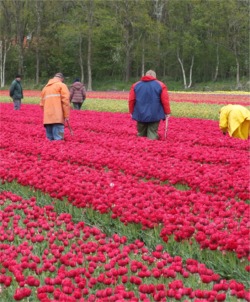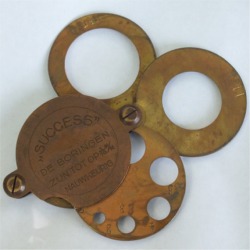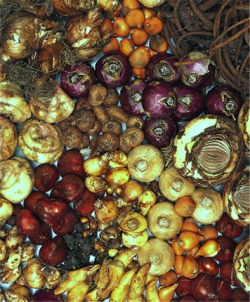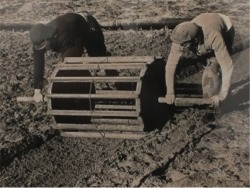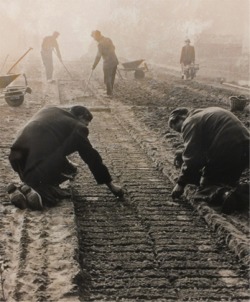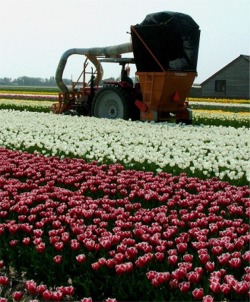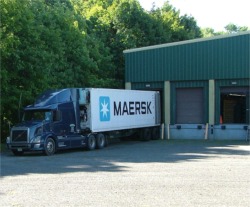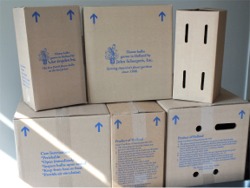 Flower Bulb Inspection
Flower Bulb Inspection
We carry the very highest quality of flower bulbs from the annual Dutch harvest. Everything that we do, all year long, is geared toward selecting and assuring the highest quality of flower bulbs for our clients. It’s that simple.
Each of our 800+ varieties of flower bulbs and Peonies are carefully inspected by Dutch and American agricultural inspectors during the spring flowering season and summer harvest in the Netherlands. Our devoted Dutch growers deliver our bulbs to our highly esteemed export colleagues. They inspect them again for top size, health and quality before packaging them and loading them into temperature and humidity controlled containers for us. After two weeks crossing the Atlantic, our containers are trucked ASAP to our state-of-art warehouse in Bantam, CT.
We receive containers of flower bulbs from late August through the middle of October each season. Every single container is opened and inspected. First, the smell test. Second, the two interior temperature and humidity recording devices are double checked to make sure that the container maintained itself correctly during its voyage. Third, every variety is personally inspected by our well-trained and experienced Quality Control staff for bulb size and tip-top health. If there is any issue whatsoever, all of the packages of that variety are opened and any unfortunate bulbs are culled out and it is double-checked every week during the season.
Flower Bulb Size
Each flower bulb variety produces its own annual top size bulb that is measured at the time of harvest. All of our variety descriptions include the top-size centimeter circumference measurement of that particular bulb. A measurement of circumference is taken by measuring around the widest girth of the bulb, as if one were measuring one's waist: not a straight line measurement from left to right. For each variety, only top-size bulbs that are as large as, or larger, than the specified centimeter size are used. In the warehouses of our Dutch export colleagues, there are crazy conveyor belts that have holes in them that match the designated centimeter top size. The conveyor belt shakes a bit and smaller bulbs not up to size fall through the holes and are not used. If a crop experiences an issue and the bulbs no longer meet our quality standards, we reject the crop and contact our customers individually to inform them of the crop failure and provide suggestions about alternate selections.
In any one bag of bulbs, you might find some different sizes. Please rest assured that the smallest of the bulbs is at least the size specified for that variety: the others are larger than the size specified: kind of like a bulb bonus.
How a Bulb Looks
Individual varieties of flower bulbs have different bulb shapes. Some flower bulbs, like Narcissi, may have attached to the 'mother' bulb a baby bulb or two, known as bulblets or offshoots. They need not be broken off from the mother bulb prior to planting. Yet if they break off, you can just plant them at the same depth and space apart as the mother bulb. Other bulbs, like Allium and Fritillaria, may have a 'flat' side. This is how some bulbs multiply, by creating split-aparts when the woody stem splits them apart underground as they grow and plump up. Some bulbs have a texture much different than a firm Tulip, like Muscari or Camassia that have a little give to them when you squeeze them, or some Crocus that appear to have a netted surface. Some look like weird, wizened little pellets like, Anemone blanda. Some bulbs smell rather unpleasant, like Fritillaria.
In days of old, flower bulbs were individually hand dug when they were harvested. Today, special harvesting equipment is used and, for the most part, bulbs are harvested en masse. Small nicks or scars may be visible from machine harvest but do not affect the bulb's performance. The papery sheaths surrounding some bulbs, like Tulips or Narcissi, may or may not be intact after they are washed and dried. It has no bearing on the vitality or performance of the bulb.
Our flower bulbs are carefully loaded on to 68°F temperature- and humidity-controlled containers that travel by ship across the Atlantic Ocean. Once they are released from port, the refrigerated containers are trucked to us immediately for inspection and acceptance in our warehouse.
During this Atlantic crossing, some bulbs, like Tulips or Muscari, may develop a blue-green surface mold, commonly known as a 'transportation mold'. It is a natural phenomenon that occurs when some bulbs are out of the soil and exposed to oxygen. This mold is actually extinguished by the lack of oxygen and wicked away by the soil when the bulbs are replanted. However, if you want to, you may gently remove the mold with a paper towel, or let them air out in the sun for an afternoon. We do that sometimes here. A little sun or extra air circulation with serious fans do the trick.
Some bulbs, like Lilies or Hyacinths, may have retained harvest moisture. Occasionally, a bulb may have a thin layer of soft outer scales. This thin layer may be gently rubbed off or aired out in the sun for an afternoon or left as is since the soil will wick the moisture away once planted.
As long as the bulb is firm, there is nothing to worry about. In a nutshell, a firm bulb is a viable bulb. But if you have any questions about any of your bulbs, just call us. We have a phenomenal team in our customer service house who are ready to help you.
We don’t receive all of our bulbs at once. We receive them as they are available from the harvest in staggered shipments from late August through mid-October. We ship orders out with a first bulbs in, first bulbs out system.
Our Amazing Team
We have a great team of 100+ staff in our 30,000 square foot warehouse. A good 70% of our seasonal warehouse staff come back every fall. Our staff is well-trained and well-experienced. Some of us have been working together for twenty to thirty years. Cees van Roon, a prominent worldwide flower bulb expert in the Netherlands, joins us for a busman’s holiday for two weeks each September. He works with our Quality Control team and teaches them every way to examine our bulbs before we ship them to you.
Our warehouse is cleaned from top to bottom every summer in advance of the shipping season: the ceilings, the fans, the lights, the walls and all of the racking and equipment. The warehouse floors are scrubbed and repainted every year. We have a state-of-art air circulation and ventilation system. It is a positive pressure system that completely renews the warehouse air five times an hour. It is perfect for the bulbs, and has been a blessing during the pandemic when fresh air circulation helps keep everyone safe and healthy.
